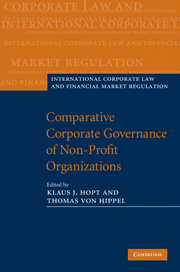Book contents
- Frontmatter
- Contents
- List of contributors
- Preface
- Abbreviations
- PART I Economic findings and theories on nonprofit organizations
- PART II The nonprofit sector: private law, trust law, tax law in selected countries
- PART III The board of nonprofit organizations
- PART IV Good governance of nonprofit organizations: activities and regulatory problems
- 10 Fundraising
- 11 Asset management in nonprofit organizations
- 12 Nonprofit organizations and economic activities/enterprises
- 12.1 Nonprofit organizations and economic activities/enterprises
- 12.2 Nonprofit organizations and enterprises: the Danish foundation law as an example
- 12.3 The protection of members and creditors of nonprofit organisations
- PART V Good governance of nonprofit organizations: self-regulation, disclosure and supervision
- Index
- References
12.3 - The protection of members and creditors of nonprofit organisations
from 12 - Nonprofit organizations and economic activities/enterprises
Published online by Cambridge University Press: 05 August 2011
- Frontmatter
- Contents
- List of contributors
- Preface
- Abbreviations
- PART I Economic findings and theories on nonprofit organizations
- PART II The nonprofit sector: private law, trust law, tax law in selected countries
- PART III The board of nonprofit organizations
- PART IV Good governance of nonprofit organizations: activities and regulatory problems
- 10 Fundraising
- 11 Asset management in nonprofit organizations
- 12 Nonprofit organizations and economic activities/enterprises
- 12.1 Nonprofit organizations and economic activities/enterprises
- 12.2 Nonprofit organizations and enterprises: the Danish foundation law as an example
- 12.3 The protection of members and creditors of nonprofit organisations
- PART V Good governance of nonprofit organizations: self-regulation, disclosure and supervision
- Index
- References
Summary
Introduction
Nonprofit organisations are not governed by a uniform legal regime, but can be established in accordance with a variety of different regulations. The protection of the creditors and members of a nonprofit organisation largely depends on the legal form of the organisation. The most important legal forms employed for establishing nonprofit organisations are associations, foundations and limited liability companies. In Germany, associations are governed by section 21 BGB (German Civil Code) (eingetragener Verein, “registered association”), and foundations by section 80 BGB. In respect of the latter, however, the BGB only provides for a general civil law framework. In addition, specific state laws on foundations apply in practically all German federal states; they primarily address regulatory aspects, but they also include civil law provisions. Therefore, we need to distinguish between some 10 or 15 different subtypes of foundations. Limited liability companies are generally subject to the GmbHG (Act on Limited Liability Companies), which is designed for profit-oriented limited liability companies but equally applies to nonprofit-oriented limited liability companies. In Austria, associations are governed by the Vereinsgesetz (Act on Associations) of 2002; foundations are subject to two different acts, namely the Privatstiftungsgesetz (“PSG”, Act on Private Foundations) on the one hand and traditional foundation law pursuant to the Bundesstiftungsgesetz (Federal Act on Foundations) on the other. While private foundation law applies to both profit-oriented and nonprofit-oriented private foundations, federal foundation law applies exclusively to nonprofit foundations. In practice, the PSG, which entered into force in 1993, is clearly more important.
- Type
- Chapter
- Information
- Comparative Corporate Governance of Non-Profit Organizations , pp. 789 - 812Publisher: Cambridge University PressPrint publication year: 2010

